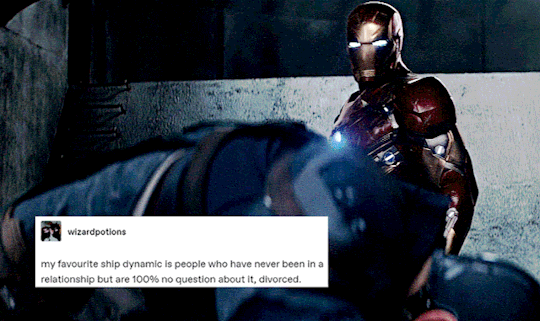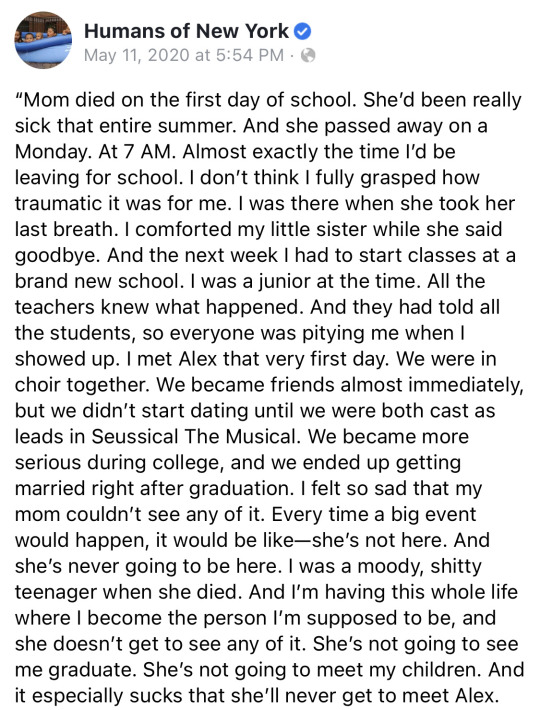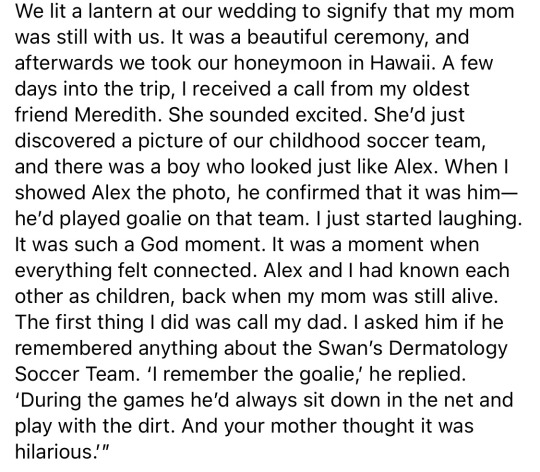Text
This user supports AO3
This user is anti-censorship
This user believes in “don’t like, don’t read”
This user believes in “ship and let ship”
This user believes that fiction tastes and preferences do not dictate moral character
63K notes
·
View notes
Text
re-reading my own fic because the author has exactly my taste in tropes, ships the same ships in the right way, and also shares my sense of humour. what a find, what a revelation. i hope they write more of this sort of thing.
15K notes
·
View notes
Link
“A young scientist who worked in the jungles of Thailand has been awarded a national prize for his invention of a $2 paper microscope that can be taken on field expeditions.
If a scientist wants to study something at the microscopic level, they need a microscope, which if they are deep in the Amazon Rainforest presents a serious problem.
Stanford University bioengineer Manu Prakash saw in his team’s $50,000 microscope a serious contradiction. As well as being bulky and ridiculously challenging to transport to remote locations, it needed training from skilled technicians to know how to use it. It also had to stay well out of the weather and other environmental impacts.
So he invented a portable one. Costing $1.75, the Foldscope has a 140x zoom, which is a small enough field to see a malaria parasite inside a cell…
“I want to bring science into everyone’s hands, make it more personal,” Prakash told CNN. “We have decoupled everyday life from the process of science.”
The ultimate in schoolhouse science, Prakash’s invention has sold 1.6 million units, mostly to schools in America, but serious scientists are also using it—like Dr. Kirti Nitnaware in India who works on the isolation and characterization of bioactive metabolites in cyanobacteria.
She used the Foldscope last year to isolate a new species of cyanobacteria. For this and other reasons, Prakash received the 2022 Golden Goose Award from the American Association for the Advancement of Science (AAAS), parent company of the scientific journal, Science.
“The Golden Goose Award reminds us that potential discoveries could be hidden in every corner and illustrates the benefits of investing in basic research to propel innovation,” said Sudip S. Parikh, chief executive officer at AAAS.” -via Good News Network, 9/20/22
5K notes
·
View notes
Text
Van Helsing in movie adaptations: Dracula's nemesis
Van Helsing in the book: Dracula's real estate lawyer's wife's girlfriend's fiancé's boyfriend's university professor
28K notes
·
View notes
Text
Reblogging this masterpiece for reasons (reasons being I love them)

this post
1K notes
·
View notes
Text

#taz balance#Lucretia#Taako#thinking about these two again#maybe... they were best friends#maybe the betrayals hurt all the worst#maybe they were able to find each other again and find a way forward#I want them to be happy#that hug is so soft and good bless you OP
620 notes
·
View notes
Text
This is... so soft



redraw of this from 3 years ago
#TAZ balance#Taako#Barry Bluejeans#I never see enough of these you and you do them such justice#have I mentioned how much I adore your designs?#your designs are AMAZING and especially your Taako#but also the color schemes and the calm backdrop#the stars in the sky#and the dialogue is so sweet and perfect and them#your before was also good but you've gotten so much better in just a few years!#love soft post-canon found family
226 notes
·
View notes
Text
"Chicago’s 82-story Aqua Tower appears to flutter with the wind. Its unusual, undulating facade has made it one of the most unique features of Chicago’s skyline, distinct from the many right-angled glass towers that surround it.
In designing it, the architect Jeanne Gang thought not only about how humans would see it, dancing against the sky, but also how it would look to the birds who fly past. The irregularity of the building’s face allows birds to see it more clearly and avoid fatal collisions. “It’s kind of designed to work for both humans and birds,” she said.
As many as 1 billion birds in the US die in building collisions each year. And Chicago, which sits along the Mississippi Flyway, one of the four major north-south migration routes, is among the riskiest places for birds. This year, at least 1,000 birds died in one day from colliding with a single glass-covered building. In New York, which lies along the Atlantic Flyway, hundreds of species traverse the skyline and tens of thousands die each year.
As awareness grows of the dangers posed by glistening towers and bright lights, architects are starting to reimagine city skylines to design buildings that are both aesthetically daring and bird-safe.
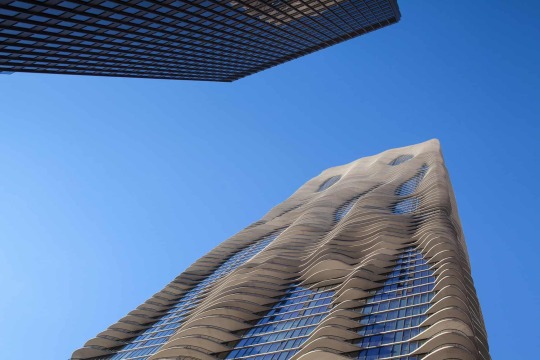
Pictured: Chicago's Aqua Tower was designed with birds in mind.
Some are experimenting with new types of patterned or coated glass that birds can see. Others are rethinking glass towers entirely, experimenting with exteriors that use wood, concrete or steel rods. Blurring lines between the indoors and outdoors, some architects are creating green roofs and facades, inviting birds to nest within the building.
“Many people think about bird-friendly design as yet another limitation on buildings, yet another requirement,” said Dan Piselli, director of sustainability at the New York-based architecture firm FXCollaborative. “But there are so many design-forward buildings that perfectly exemplify that this doesn’t have to limit your design, your freedom.”
How modern buildings put birds in danger
For Deborah Laurel, principal in the firm Prendergast Laurel Architects, the realization came a couple of decades ago. She was up for an award for her firm’s renovation of the Staten Island Children’s Museum when the museum’s director mentioned to her that a number of birds had been crashing into the new addition. “I was horrified,” she said.
She embarked on a frenzy of research to learn more about bird collisions. After several years of investigation, she found there was little in the way of practical tips for architects, and she teamed up with the conservation group NYC Audubon, to develop a bird-safe building guide.
The issue, she discovered, was that technological and architectural advancements over the last half-century had in some ways transformed New York City – and most other US skylines and suburbs – into death traps for birds...
At certain times of day, tall glass towers almost blend into the sky. At other times, windows appear so pristinely clear that they are imperceptible to birds, who might try to fly though them. During the day, trees and greenery reflected on shiny building facades can trick birds, whereas at night, brightly lit buildings can confuse and bewilder them...

Pictured: A green roof on the Javits Convention Center serves as a sanctuary for birds.
The changes that could save avian lives
About a decade ago, Piselli’s firm worked on a half-billion-dollar renovation of New York’s Jacob K Javits Convention Center, a gleaming glass-clad space frame structure that was killing 4,000-5,000 birds a year. “The building was this black Death Star in the urban landscape,” Piselli said.
To make it more bird friendly, FXCollaborative (which was then called FXFowle) reduced the amount of glass and replaced the rest of it with fritted glass, which has a ceramic pattern baked into it. Tiny, textured dots on the glass are barely perceptible to people – but birds can see them. The fritted glass can also help reduce heat from the sun, keeping the building cooler and lowering air conditioning costs. “This became kind of the poster child for bird-friendly design in the last decade,” Piselli said.
The renovation also included a green roof, monitored by the NYC Audubon. The roof now serves as a sanctuary for several species of birds, including a colony of herring gulls. Living roofs have since become popular in New York and other major cities, in an inversion of the decades-long practice of fortifying buildings with anti-bird spikes. In the Netherlands, the facade of the World Wildlife Fund headquarters, a futuristic structure that looks like an undulating blob of mercury, contains nest boxes and spaces for birds and bats to live.
The use of fritted glass has also become more common as a way to save the birds and energy.
Earlier this year, Azadeh Omidfar Sawyer, an assistant professor in building technology in the Carnegie Mellon School of Architecture, working with student researchers, used open-source software to help designers create bespoke, bird-friendly glass patterns. A book of 50 patterns that Sawyer published recently includes intricate geometric lattices and abstract arrays of lines and blobs. “Any architect can pick up this book and choose a pattern they like, or they can customize it,” she said.
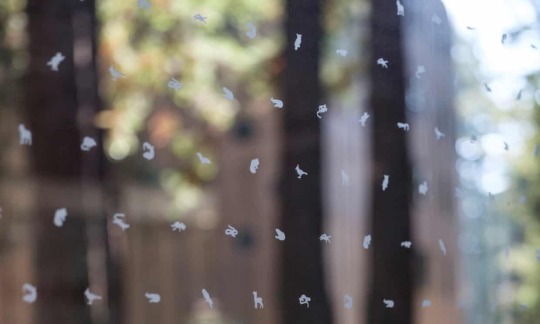
Pictured: The fritted glass used in Studio Gang’s expansion of Kresge College at the University of California, Santa Cruz, depicts the animals in the local ecosystem.
Builders have also been experimenting with UV-printed patterns, which are invisible to humans but perceptible to most birds. At night, conservationists and architects are encouraging buildings turn off lights, especially during migration season, when the bright glow of a city skyline can disorient birds.
And architects are increasingly integrating screens or grates that provide shade as well as visibility for birds. The 52-floor New York Times building, for example, uses fritted glass clad with ceramic rods. The spacing between the rods increases toward the top of the building, to give the impression that the building is dissolving into the sky.
Gang’s work has incorporated structures that can also serve as blinds for birders, or perches from which to observe nature. A theater she designed in Glencoe, Illinois, for example, is surrounded by a walking path made of a wood lattice, where visitors can feel like they’re up in the canopy of trees.

Pictured: The Writers Theatre, designed by Studio Gang, includes a walking path encased in wood lattice.
Rejecting the idea of the iridescent, entirely mirrored-glass building, “where you can’t tell the difference between the habitat and the sky”, Gang aims for the opposite. “I always tried to make the buildings more visible with light and shadow and geometry, to have more of a solid presence,” she said.
Gang has been experimenting with adding bird feeders around her own home in an effort to reduce collisions with windows, and she encourages other homeowners to do the same.
“I’ve found that birds slow down and stop at feeders instead of trying to fly through the glass,” she said.
While high-rise buildings and massive urban projects receive the most attention, homes and low-rise buildings account for most bird collision deaths. “The huge challenge is that glass is everywhere.” said Christine Sheppard, who directs the glass collisions program at the American Bird Conservancy (ABC). “It’s hard to know what I know and not cringe when I look at it.”
Tips for improving your own home include using stained glass or patterned decals that can help birds see a window, she said. ABC has compiled a list of window treatments and materials, ranked by how bird-safe they are.
Whether they’re large or small, the challenge of designing buildings that are safe for birds can be “liberating”, said Gang, who has become an avid birdwatcher and now carries a pair of binoculars on her morning jogs. “It gives you another dimension to try to imagine.”"
-via The Guardian, December 27, 2023
1K notes
·
View notes
Text
In the Willamette Valley of Oregon, the long study of a butterfly once thought extinct has led to a chain reaction of conservation in a long-cultivated region.
The conservation work, along with helping other species, has been so successful that the Fender’s blue butterfly is slated to be downlisted from Endangered to Threatened on the Endangered Species List—only the second time an insect has made such a recovery.
[Note: "the second time" is as of the article publication in November 2022.]
To live out its nectar-drinking existence in the upland prairie ecosystem in northwest Oregon, Fender’s blue relies on the help of other species, including humans, but also ants, and a particular species of lupine.
After Fender’s blue was rediscovered in the 1980s, 50 years after being declared extinct, scientists realized that the net had to be cast wide to ensure its continued survival; work which is now restoring these upland ecosystems to their pre-colonial state, welcoming indigenous knowledge back onto the land, and spreading the Kincaid lupine around the Willamette Valley.
First collected in 1929 [more like "first formally documented by Western scientists"], Fender’s blue disappeared for decades. By the time it was rediscovered only 3,400 or so were estimated to exist, while much of the Willamette Valley that was its home had been turned over to farming on the lowland prairie, and grazing on the slopes and buttes.
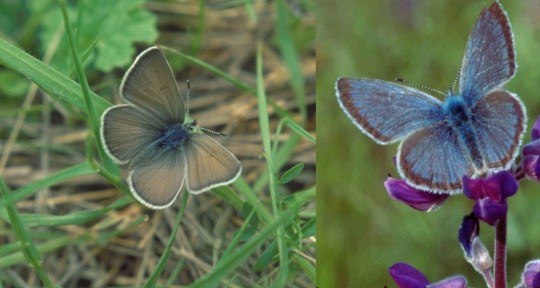
Pictured: Female and male Fender’s blue butterflies.
Now its numbers have quadrupled, largely due to a recovery plan enacted by the Fish and Wildlife Service that targeted the revival at scale of Kincaid’s lupine, a perennial flower of equal rarity. Grown en-masse by inmates of correctional facility programs that teach green-thumb skills for when they rejoin society, these finicky flowers have also exploded in numbers.
[Note: Okay, I looked it up, and this is NOT a new kind of shitty greenwashing prison labor. This is in partnership with the Sustainability in Prisons Project, which honestly sounds like pretty good/genuine organization/program to me. These programs specifically offer incarcerated people college credits and professional training/certifications, and many of the courses are written and/or taught by incarcerated individuals, in addition to the substantial mental health benefits (see x, x, x) associated with contact with nature.]
The lupines needed the kind of upland prairie that’s now hard to find in the valley where they once flourished because of the native Kalapuya people’s regular cultural burning of the meadows.
While it sounds counterintuitive to burn a meadow to increase numbers of flowers and butterflies, grasses and forbs [a.k.a. herbs] become too dense in the absence of such disturbances, while their fine soil building eventually creates ideal terrain for woody shrubs, trees, and thus the end of the grassland altogether.
Fender’s blue caterpillars produce a little bit of nectar, which nearby ants eat. This has led over evolutionary time to a co-dependent relationship, where the ants actively protect the caterpillars. High grasses and woody shrubs however prevent the ants from finding the caterpillars, who are then preyed on by other insects.
Now the Confederated Tribes of Grand Ronde are being welcomed back onto these prairie landscapes to apply their [traditional burning practices], after the FWS discovered that actively managing the grasslands by removing invasive species and keeping the grass short allowed the lupines to flourish.
By restoring the lupines with sweat and fire, the butterflies have returned. There are now more than 10,000 found on the buttes of the Willamette Valley."
-via Good News Network, November 28, 2022
4K notes
·
View notes
Text
TAZ, TAZ balance, zine, done!, signed up for writing, will always write for my girl Lucretia, haven’t done a zine since Coco

WHOA
Magnus RUSHES IN….
to fill out our interest check!
>>
253 notes
·
View notes
Text
reading another post about how characters don't know what genre they're in, and thought of this again because Lucretia... my god, Lucretia, my love, is such a lit major. She knows she's in a horror by the end and is so determined to put a stop to it.
I never noticed the sharp contrast between the IPRE and the BoB logos, I wonder if Griffin even noticed, that's brilliant! The colors, the imagery and symbolism. I also really wonder who first decided they were the Seven Birds, and if they knew they were falling into one of the oldest (real life) mythologies of humankind, or if it was all a big, stupid coincidence, and it makes me go feral.
there really are so many symbolic choices, though, that Lucretia made to emphasize the Bureau of Balance and the Red Robes as foils, right down to things that would literally only mean anything to her (and maybe Barry, if he happened to be spying on the Bureau, which I'm sure Lucretia knew that he was).
like. the alliteration and colors are one thing, because any old Regulator or Seeker hearing the story of the Red Robes could pick up on those. but the fact that the IPRE logo is entirely round, entirely made of circles, while the BoB logo is all triangles and diamonds, all sharp angles? let alone the fact that the IPRE's home planet had two suns, while the Bureau created an entire second moon? like. god. she's such a literature major. I love her.
#taz balance#taz#Lucretia#Seven Birds#she's a lit major your honor#btw I love your writing and characterization and beautiful brain ideas
276 notes
·
View notes
Text
some facts for western christians this holiday season:
jesus’ birthplace is under military occupation
bethlehem is surrounded by military checkpoints, an apartheid wall, and over 20 segregated illegal settlements built on stolen land - all designed to keep palestinians (including palestinian christians) under the thumb of oppression
palestinian christians are not allowed to move without restrictions, meaning that many have never and will never see their own holy sites in jerusalem. jerusalem is less than 30 minutes away.
they are often harassed, beaten, or even killed on holidays like christmas and easter.
palestinian christians are forced out of their homes as israel continues to build apartheid walls and illegal settlements
churches have been deliberately targeted in airstrikes, arson attacks, and settler violence
nuns and other clergy have been targeted in violent attacks
indigenous christians of the holy land have begged for help from christian communities abroad, fearing for their lives and even a possible extinction, according to christian religious leaders there
and finally, a message from the archbishop of jerusalem:
24K notes
·
View notes
Text
my friend took in a stray and she’s the cutest kitty ever but he named her oil so whenever he sends a picture of her me and my other friends look like we’re roleplaying as the US military
257K notes
·
View notes



